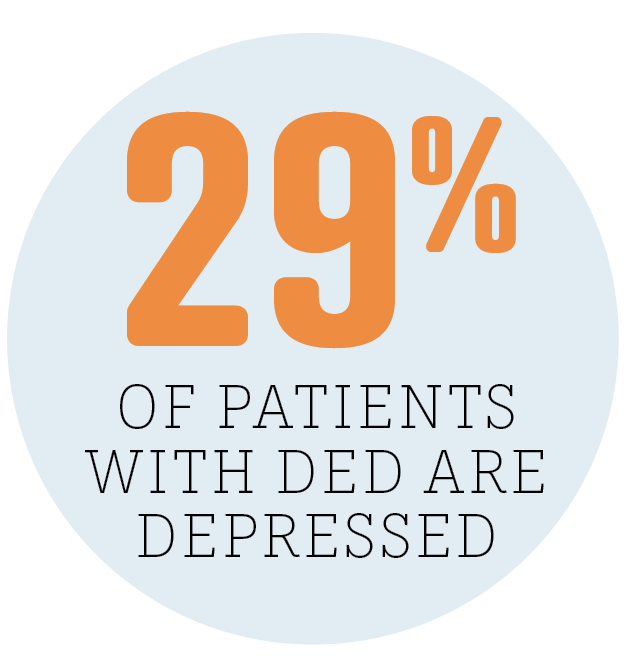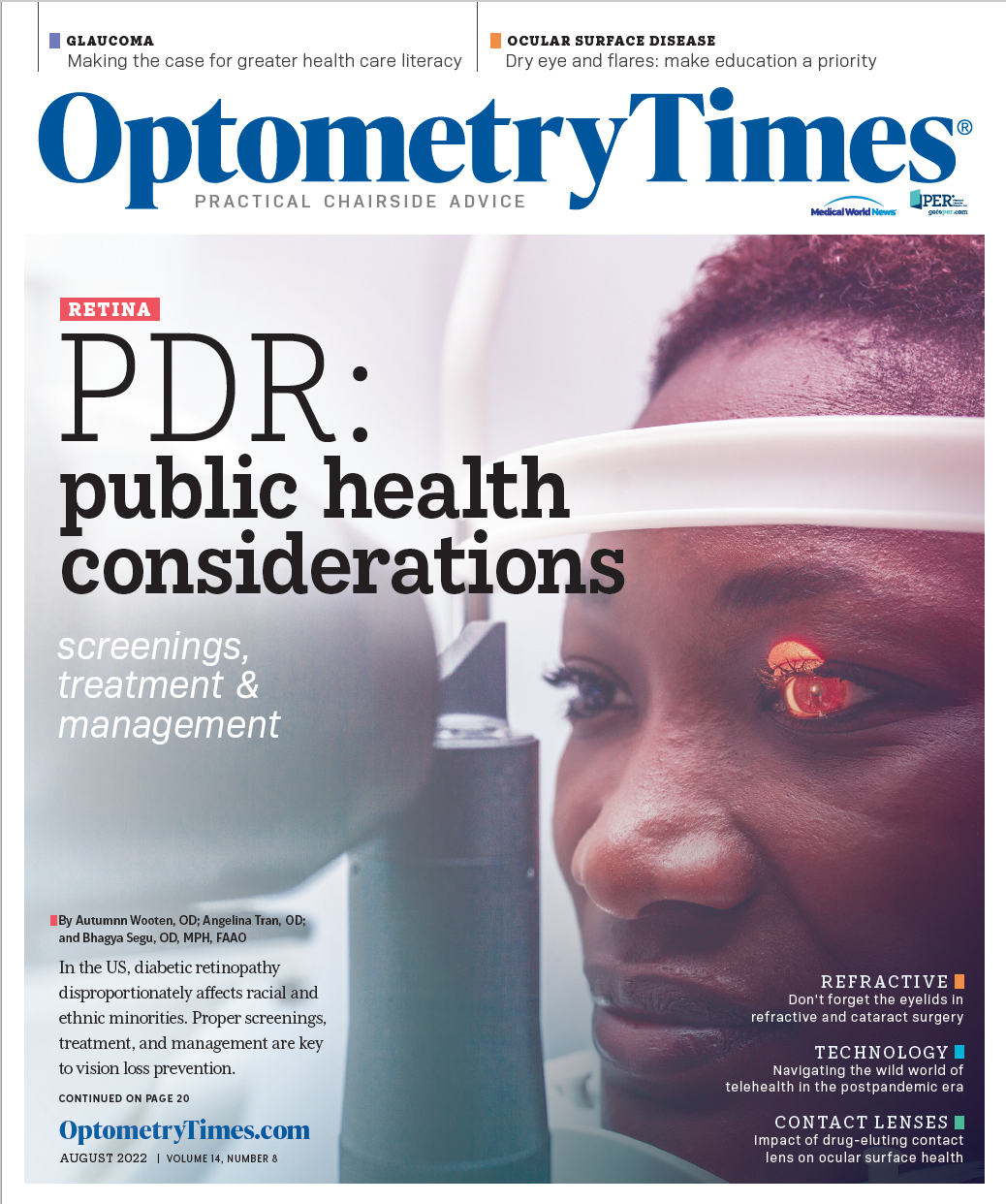Dry eye and flares: make education a priority
Ensure successful symptoms management with your patients.

Dry eye disease (DED) is a chronic inflammatory condition characterized by episodic exacerbations of symptoms, known as flares. About 80% of patients experience acute flares—which are triggered by a variety of factors—while nearly 50% experience only episodic, rather than continuous, symptoms.1-7
Inflammation and how to stop it
Ocular surface inflammation is a feature of all forms of DED, irrespective of etiology.1
Inflammation is associated with an upregulation of intercellular adhesion molecule-1 along with matrix metalloproteinases, chemokines, tumor necrosis factor alpha, and interleukins (IL-1,6, and 8) in the epithelial cells of conjunctival and lacrimal tissue.
These enzymes and inflammatory cells set off a cascade of events, including the proliferation of T cells that trigger a neurosensory response that causes discomfort and irritation.8,9
Before the FDA approved Eysuvis (loteprednol etabonate ophthalmic suspension 0.25%; Alcon) in October 2020, ODs would frequently turn to off-label corticosteroid drops to quell flares, as these agents had been shown to suppress innate and adaptive immune responses quickly and effectively.1,2,10-13
A well-studied option
Loteprednol etabonate was studied in more than 2,800 patients with DED and was well-tolerated, with a similarly low incidence of intraocular pressure (IOP) increase in the treatment and vehicle groups: 0.2% and 0% of subjects (treatment and vehicle, respectively) experienced a ≥ 10 mm Hg increase from baseline, resulting in an IOP measurement of ≥ 21 mm Hg at any post-baseline visit up to 29 days.14-16
The most common adverse event was instillation site pain, which was reported by 5% of subjects in the treatment arm and 4% in the vehicle arm.
Investigators observed a statistically significant improvement in both the conjunctival hyperemia severity scale and the patient-reported ocular discomfort severity score among subjects dosed 4 times a day for 2 weeks.
Those treated with loteprednol etabonate experienced an improvement in symptoms as early as day 2, which reached statistical significance at day 4.14-16
Our treatment approaches and patient-centric philosophies

Education is a cornerstone of both of our practices. We explain what DED is, what triggers it, and how to treat it. We find that enlisting patients as partners improves therapy adherence and therefore outcomes.
Dr. Brimer
My goal always is to identify the root cause of patients’ ocular surface disease. No matter what the trigger is, inflammation is likely present and a prominent player in the mix.
I wrote a 132-page booklet, with references, that I give to every new patient. It covers everything from “why me” to “what can we do about it.”
I make it clear that the condition is not curable; therefore, being proactive in terms of lifestyle, environment, and therapy—as well as compliant with treatment—are crucial to keeping symptoms at bay.
I talk about the interaction of stress, anxiety, and depression with DED (29% of patients with DED are depressed).17
I also outline how nonpharmaceutical interventions like nutritional supplements, diet, hydration, changes in environment, and getting enough sleep and exercise factor into their condition.
In terms of diet, I talk about anti- and pro-inflammatory foods, noting the Arthritis Foundation diet and how patients can eat better without thinking about it. I cover make-up habits, digital device use, and blinking exercises.
The last section of the book is about treatment options, and I include the data that supports my recommendations. I talk about “good, better, and best” options for success. Lifestyle modifications and a medical-grade supplement are good; chronic therapy is better; and best is an intervention like short-term prescription corticosteroids in conjunction with intense pulsed light (IPL) therapy.
Whenever possible, I like to do an in-office evaluation first to address the patient’s symptomatic needs.
The book helps patients take control, and ownership, of their condition. Effective DED management requires a team mindset and approach. Many of my patients tell me that it is not just their eyes that improve by following these suggestions, they feel better in general.
I always walk patients through what is going on with their eyes using images and videos from the Oculus Keratograph 5M to make sure they understand that we are going to make a treatment plan together.
I tell them we will identify the underlying causes of their condition and then choose treatments that I know will work based on their specific disease process. Including patients in the decision-making process bolsters loyalty.
Everyone has different therapeutic goals: Some people want treatment that is fast; others want easy, natural, or inexpensive. I let them know I can do any of those, but I can’t do them all.
I attack DED aggressively to keep patients from having flares repeatedly. Still, a subset will have breakthrough symptoms. In these cases, I prescribe loteprednol etabonate 4 times a day for a week and advise them to then start tapering off.
Ultimately, I want them to be proactive and try to keep symptoms from getting worse with hygiene (lid scrubs, wipes, etc.) first. When needed, I do not hesitate to add the corticosteroid drop to manage future flares.
Dr. Wruble
There are many causes of acute exacerbations in DED, and the environment is an important one. Climate change has led to longer allergy seasons, and in many places pollution has increased.18
The COVID-19 pandemic has certainly played a role in upping screen time and digital device use, which can lead to an increase in symptoms as well a new phenomenon called mask-associated dry eye (MADE).19
It is important to have directed conversations with patients about their acute dry eye flares. I tell them that we are going to set up a treatment plan to keep them comfortable at all times, not just during an acute increase in symptoms. We want to be proactive and decrease the frequency of future flares.
I give patients a copy of our practice’s dry eye protocol, highlighting those parts that apply to them. My goal is for patients to understand that this is not a one-time, one-day approach. Keeping their DED symptoms at bay is going to require changes to their lifestyle and environment.
I also emphasize hydration and explain how to calculate the amount of water they should be drinking. We talk about avoiding smoke, using humidifiers, and keeping vents from blowing directly on their face. I may have them wear an eye mask at night and use lubricants.
For patients taking chronic therapy, I review the medications and confirm that they are using their drops as directed. I emphasize the importance of consistency to prevent acute symptom flares. When flares happen, I prescribe loteprednol etabonate to address the inflammatory cascade and help improve signs and symptoms quickly.
I refer to loteprednol etabonate as a rescue drop, likening it to an inhaler for an asthma attack. I educate patients on the importance of using it only in this manner and ask them to let me know how frequently they need it.
Patients follow up with me if they are not getting relief. If they ask to refill the prescription too soon, I see them again to reevaluate and correct their treatment plan, which might include a chronic therapy coupled with short-term prescription treatment for breakthrough flares.
Dry eye can go undiagnosed, especially if we are not intentional when asking questions to uncover and define underlying symptoms.
We need to open the door by using questionnaires and having our technicians query patients about certain hot-topic symptoms, such as blurred vision or red/sandy/gritty eyes, that might trigger a memory and ask about what over-the-counter and/or prescription drops they have used in the past.
My treatment choices depend on the specific diagnosis and personal triggers, and I pay close attention to how systemic inflammation might be influencing the ocular surface response. With that said, patient discussion centers on supplements and diet, which are important pieces of the dry eye puzzle
Conclusion

Our approaches to managing DED and inflammation are comprehensive, addressing both whole body health and environmental factors as well as patients’ signs and symptoms. Although we seek to prevent flares in our dry eye patients, when they do occur, we do not hesitate to attack them by using loteprednol etabonate.
References
1. Craig JP, Nichols KK, Akpek EK, et al. TFOS DEWS II definition and classification report. Ocul Surf. 2017;15(3):276-283. doi: 10.1016/j.jtos.2017.05.008
2. Perez VL, Stern ME , Pflugfelder SC. Inflammatory basis for dry eye disease flares. Exp Eye Res. 2020;201:108294. doi: 10.1016/j.exer.2020.108294
3. Lienert JP, Tarko L, Uchino M, Christen WG, Schaumberg DA. Long-term natural history of dry eye disease from the patient’s perspective. Ophthalmology. 2016;123(2):425-433. doi: 10.1016/j.ophtha.2015.10.011
4. Brazzell RK, Zickl L, Farrelly J, et al. Prevalence and characteristics of dry eye flares: a patient questionnaire survey. Poster presented at: American Academy of Optometry Annual Meeting; Oct 12-15, 2019; San Francisco, California. Accessed
5. Brazzell RK, Zickl L, Farrelly J, et al. Prevalence and characteristics of symptomatic dry eye flares: results from patient questionnaire surveys. Poster presented at: American Academy of Optometry Annual Meeting: October 23-27, 2019; Orlando, Florida.
6. 2018 Study of Dry Eye Sufferers. Conducted by Multi-sponsor Surveys, Inc.
7. 2020 Study of Dry Eye Sufferers. Conducted by Multi-sponsor Surveys, Inc.
8. Pflugfelder SC, de Paiva CS. The pathophysiology of dry eye disease: what we know and future directions for research. Ophthalmology. 2017;124(11S):S4–S13. doi: 10.1016/j.ophtha.2017.07.010
9. Gao J, Morgan G, Tieu D, et al. ICAM-1 expression predisposes ocular tissues to immune-based inflammation in dry eye patients and Sjögrens syndrome-like MRL/lpr mice. Exp Eye Res. 2004;78(4):823-835. doi: 10.1016/j.exer.2003.10.024
10. Amparo F, Dana R. Web-based longitudinal remote assessment of dry eye symptoms. Ocul Surf. 2018;16(2)249-253. doi: 10.1016/j.jtos.2018.01.002
11. Iyer JV, Lee SY, Tong L. The dry eye disease activity log study. Sci World J. 2012; 2012: 589875. doi: 10.1100/2012/589875
12. Kim Y, Paik HJ, Kim MK, Choi YH, Kim DH. Short-term effects of ground-level ozone in patients with dry eye disease: a prospective clinical study. Cornea. 2019;38:1483-1488. doi: 10.1097/ICO.0000000000002045
13. Bron AJ, de Paiva CS, Chauhan SK et al. TFOS DEWS II pathophysiology report. Ocul Surf. 2017;15(3):438-510. doi: 10.1016/j.jtos.2017.05.011
14. Gupta PK, Venkateswaran N. The role of KPI-121 0.25% in the treatment of dry eye disease: penetrating the mucus barrier to treat periodic flares. Ther Adv Ophthalmol. 2021;13:25158414211012797. doi: 10.1177/25158414211012797
15. Korenfeld M, Nichols KK, Goldberg D, et al. Safety of KPI-121 ophthalmic suspension 0.25% in patients with dry eye disease: a pooled analysis of 4 multicenter, randomized, vehicle-controlled studies. Cornea. 2021;40(5):564-570. doi: 10.1097/ICO.0000000000002452
16. Holland E, Nichols KK, Foulks GN, et al. Safety and efficacy of KPI-121 ophthalmic suspension 0.25% for DED in four RCTs. Paper presented at: American Academy of Ophthalmology Annual Meeting; Nov 13-15, 2020; Virtual. Accessed July 21, 2022.
17. Kitazawa M, Sakamoto C, Yoshimura M, et al. The relationship of dry eye disease with depression and anxiety: a naturalistic observational study. Transl Vis Sci Technol. 2018;7(6):35. doi: 10.1167/tvst.7.6.35
18. Zhang Y, Steiner AL. Projected climate-driven changes in pollen emission season length and magnitude over the continental United States. Nat Commun. 2022;13(1):1234. doi: 10.1038/s41467-022-28764-0
19. Moshirfar M, West WB Jr, Marx DP. Face mask-associated ocular irritation and dryness. Ophthalmol Ther. 2020;9(3):397-400. doi: 10.1007/s40123-020-00282-6

Newsletter
Want more insights like this? Subscribe to Optometry Times and get clinical pearls and practice tips delivered straight to your inbox.